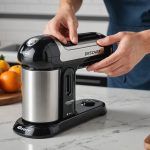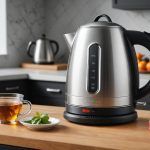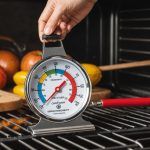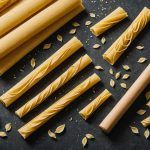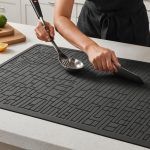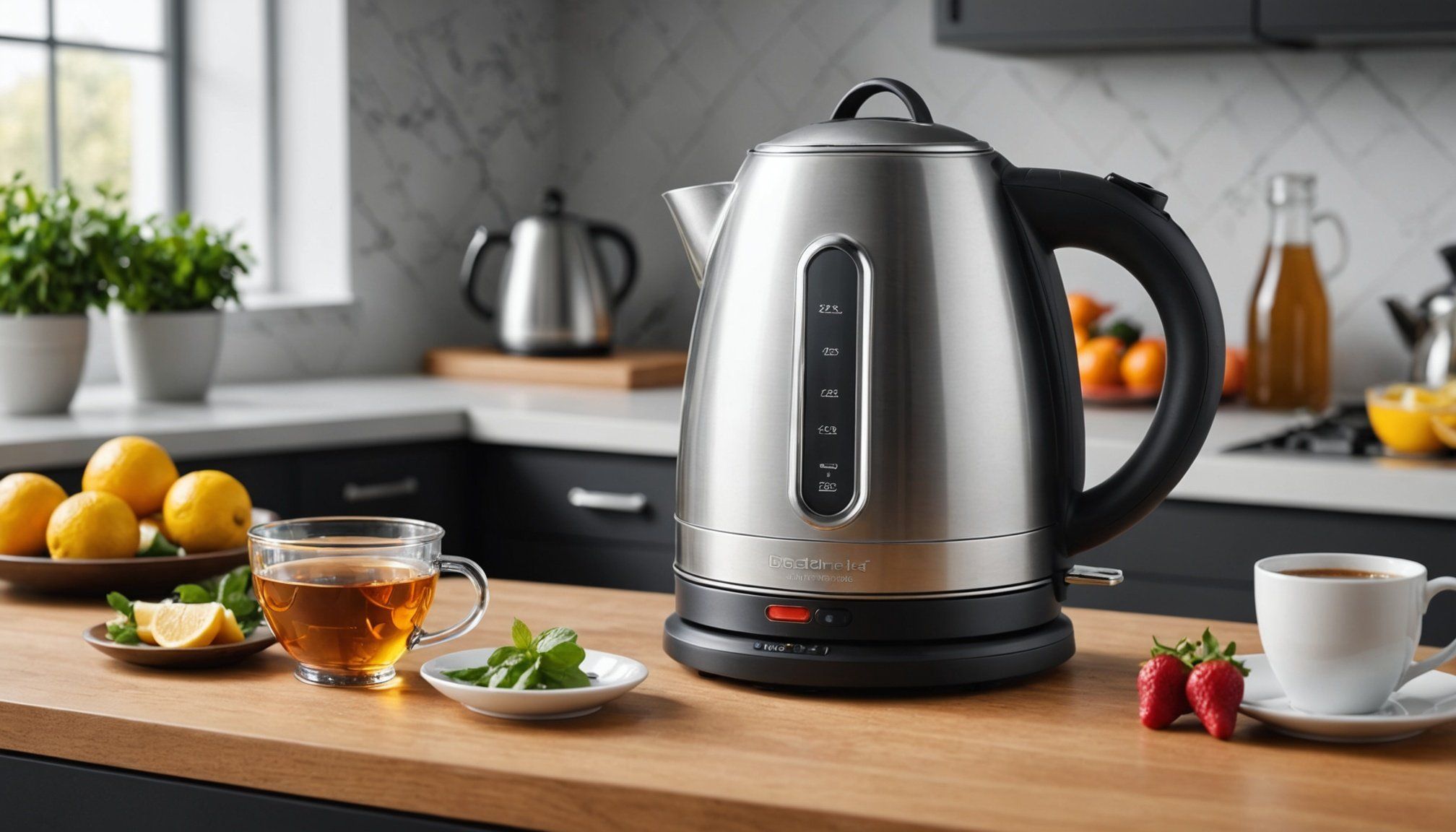The Ultimate Guide to the Healthiest Electric Kettle Materials: Which One is the Safest for You?
When it comes to choosing the perfect electric kettle, one of the most critical factors to consider is the material it’s made of. The material not only affects the durability and performance of the kettle but also the safety and healthiness of the water you boil. In this guide, we will delve into the most common materials used for electric kettles, their pros and cons, and which one is the safest for your daily use.
Understanding the Common Materials Used in Electric Kettles
Electric kettles are typically made from three primary materials: stainless steel, glass, and plastic. Each material has its unique set of advantages and disadvantages.
Have you seen this : Discover the Ultimate Cookware Choices for Perfect Induction Cooking
Stainless Steel Kettles
Stainless steel kettles are often praised for their durability and heat retention. Here are some key points to consider:
- Durability and Heat Retention: Stainless steel kettles are known for their robust construction and excellent heat retention. They are heavier and can feel more sturdy, which can be a plus for those who value longevity[2][5].
- Safety Features: Stainless steel is non-toxic and does not leach chemicals into the water, making it a safe choice. Additionally, stainless steel kettles often come with safety features like boil-dry prevention and automatic shut-off[2].
- Ease of Cleaning: While stainless steel kettles can be a bit clunkier to lift, they are generally easy to clean. The material is resistant to corrosion and can withstand harsh cleaning methods without compromising its integrity[2][5].
| Feature | Description |
|
|-----------------------------------------------------------------------------|
| Material | Stainless Steel |
| Durability | Robust and long-lasting |
| Heat Retention | Excellent heat retention |
| Safety | Non-toxic, boil-dry prevention, automatic shut-off |
| Ease of Cleaning | Easy to clean, resistant to corrosion |
| Weight | Heavier compared to other materials |
| Example | Milton Go Electro 2.0 Stainless Steel Kettle |
Glass Kettles
Glass kettles offer a clear view of the water level and are known for their aesthetic appeal.
Also to discover : Exploring the Toughest Whisk for Passionate Bakers: Uncover the Best Options for Frequent Use!
- Aesthetic Appeal: Glass kettles provide a clear view of the water level, which can be both functional and visually appealing. They are often preferred for their sleek and modern design[2][3].
- Non-Toxic: Glass is a non-toxic material that does not leach chemicals into the water, making it a healthy choice. It also does not release any metals, ensuring the purity of the water[3].
- Ease of Cleaning: Glass kettles are generally easy to clean, and the transparent material allows you to see any limescale buildup. However, they can be heavier and more prone to breaking[2][3].
| Feature | Description |
|
|-----------------------------------------------------------------------------|
| Material | Glass |
| Aesthetic Appeal | Clear view of water level, modern design |
| Non-Toxic | Does not leach chemicals into the water |
| Ease of Cleaning | Easy to clean, visible limescale buildup |
| Weight | Heavier compared to plastic kettles |
| Fragility | More prone to breaking |
| Example | Russell Hobbs 20760-10 Brita Purify Kettle |
Plastic Kettles
Plastic kettles are lightweight and often more affordable but come with some significant drawbacks.
- Lightweight and Affordable: Plastic kettles are very lightweight, even when filled with water, and are generally cheaper than their stainless steel or glass counterparts[2].
- Heat Distribution: Plastic kettles can distribute heat evenly but may not retain it as well as other materials. The exterior can also get very hot to the touch, which can be a safety concern[2].
- Chemical Leaching: One of the major concerns with plastic kettles is the potential for chemical leaching. Some plastics, especially those containing BPA, can release harmful chemicals into the boiling water[2].
| Feature | Description |
|
|-----------------------------------------------------------------------------|
| Material | Plastic |
| Weight | Lightweight |
| Affordability | Generally cheaper |
| Heat Distribution | Even heat distribution but poor heat retention |
| Safety Concerns | Exterior can get very hot, potential for chemical leaching |
| Example | Russell Hobbs Brita Purity Filter Clear Plastic Kettle |
Safety Features to Look For in Electric Kettles
Regardless of the material, there are several safety features that you should look for in an electric kettle to ensure safe and healthy use.
Boil-Dry Prevention
Boil-dry prevention is a crucial safety feature that prevents the kettle from heating up when there is no water inside. This feature helps in avoiding any potential damage to the kettle and reduces the risk of a fire[2].
Automatic Shut-Off
Automatic shut-off is another essential feature that powers down the kettle once it has reached the ideal temperature. This feature ensures that the kettle does not overheat and reduces energy consumption[2].
Concealed Heating Element
A concealed heating element makes cleaning the kettle much easier. Unlike exposed heating elements, concealed ones do not collect limescale residue, reducing the buildup of limescale in the kettle[3].
Practical Insights and Actionable Advice
When choosing the best electric kettle for your needs, here are some practical insights and actionable advice:
Consider Your Water Type
If you live in an area with hard water, it is crucial to choose a kettle with a built-in filter or one that is designed to handle limescale. Kettles like the Russell Hobbs Brita Purity Filter Clear Plastic Kettle or the COSORI Glass Electric Kettle are excellent choices for hard water areas[1][3].
Check the Power and Capacity
Ensure the kettle has the right power and capacity for your needs. A higher wattage (like 3000W) can boil water quickly, but it also consumes more energy. A capacity of 1-2 liters is usually sufficient for most households[1][3].
Look for Non-Toxic Materials
Opt for kettles made from non-toxic materials like stainless steel or glass. These materials ensure that your boiling water is free from harmful chemicals and metals[2][3].
Maintenance and Cleaning
Regular maintenance and cleaning are essential to extend the life of your kettle. Choose kettles with easy-to-clean designs and removable filters to make the process simpler[1][3].
Customer Reviews and Real-World Experiences
Customer reviews can provide valuable insights into the real-world performance of electric kettles.
- Russell Hobbs Brita Purity Filter Clear Plastic Kettle: A customer praised this kettle, saying, “The filter in this kettle makes so much difference to the water. You can tell by the taste. It’s a blessing. I have three. One for home, one for office, and one for my daughter.”[1]
- COSORI Glass Electric Kettle: Another customer noted, “Looks far more expensive and quality is great, so much better than expected. The glass is easy to clean, and the heating element is massive for a really good rolling boil. Couldn’t ask for better.”[1]
- Russell Hobbs 20760-10 Brita Purify Kettle: A user commented, “I bought this in 2020, and I’m still very happy with it. The Brita water filter is indispensable in Dorset as the water is hard as nails, and without it, your brew will taste disgusting.”[3]
Choosing the right electric kettle involves considering several factors, including the material, safety features, and your specific needs. Here is a summary of the key points:
- Stainless Steel: Durable, excellent heat retention, non-toxic, but heavier and more expensive.
- Glass: Aesthetic appeal, non-toxic, easy to clean, but heavier and more prone to breaking.
- Plastic: Lightweight, affordable, but potential for chemical leaching and poor heat retention.
By understanding these differences and considering your specific requirements, you can make an informed decision and choose the best electric kettle for your health and safety.
| Material | Pros | Cons |
|
|-----------------------------------------------------------------------|
|
| Stainless Steel| Durable, excellent heat retention, non-toxic | Heavier, more expensive |
| Glass | Aesthetic appeal, non-toxic, easy to clean | Heavier, prone to breaking |
| Plastic | Lightweight, affordable | Potential for chemical leaching, poor heat retention |
In the end, the safest and healthiest electric kettle for you will depend on your priorities and needs. Whether you opt for the durability of stainless steel, the aesthetic appeal of glass, or the affordability of plastic, ensuring the kettle is made from non-toxic materials and has essential safety features will always be the best choice.

